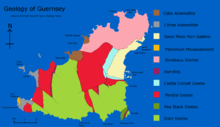- Geology of Guernsey
-
Guernsey has a geological history stretching further back into the past than most of Europe. The southern part is constructed of Icart Gneiss. The Icart Gneiss is an augen gneiss of granitic composition containing potassium feldspar. This was formed from a granite dated at 2,018 million years ago using U-Pb dating on zircon grains. A foliated Perelle quartz diorite (also called Perelle Gneiss), occurs in the centre and west of the island. This is a calc-alkaline tonalitic rock. The foliation was formed around 600 million years ago. Rafts of metamorphosed sediments, older than the gneiss are embedded between them.
The Pleinmont Formation consists of metamorphosed sediments is of unknown age. It is named after Pleinmont Point on the south west tip of the Island. These are from the Brioverian succession.
The earlier rocks, known as the pre-Cadomian basement, were then deformed in the Cadomian Orogeny. It is unknown whether this is part of a craton, a detached piece of Gondwana, or just a small island of gneiss.
The Cobo Granite is from 570 million years ago is named after Cobo Bay on the mid north coast. The north end of the island is an unfoliated calc-alkaline pluton of the Bordeaux Diorite Complex group consisting of diorite, tonalite, and granodiorite. This is also dated at 570 million years ago.
On the central east coast around Saint Peter Port is the St Peter Port Gabbro containing layers with olivine, hornblende and two kinds of pyroxene. The igneous plutonic intrusion is 2.5 km from north to south and is 0.8 km thick. The lower and upper portions are layered on the scale of a meter, while millimeter scale layering is found on the uppermost parts. This is also dated at 570 mya. Near Vale Castle the rock is of a type called bojite with interlocking hornblende and plagioclase crystals.
During the Quaternary Devensian glaciation, loess was deposited, blown in by wind from the west. The island was only separated from the continent of Europe by rising sea levels about 5000 BC during the new stone age.
References
- Great Britain: Channel Islands in Encyclopedia of European and Asian Regional Geology by Eldridge M. Moores, Rhodes Whitmore Fairbridge, Published 1997 by Springer pp 276-277.
- John Renouf: Geological excursion guide 1: Jersey and Guernsey, Channel Islands in Geology Today volume 1 number 3 1985
Geology of Europe Sovereign
states- Albania
- Andorra
- Armenia
- Austria
- Azerbaijan
- Belarus
- Belgium
- Bosnia and Herzegovina
- Bulgaria
- Croatia
- Cyprus
- Czech Republic
- Denmark
- Estonia
- Finland
- France
- Georgia
- Germany
- Greece
- Hungary
- Iceland
- Ireland
- Italy
- Kazakhstan
- Latvia
- Liechtenstein
- Lithuania
- Luxembourg
- Macedonia
- Malta
- Moldova
- Monaco
- Montenegro
- Netherlands
- Norway
- Poland
- Portugal
- Romania
- Russia
- San Marino
- Serbia
- Slovakia
- Slovenia
- Spain
- Sweden
- Switzerland
- Turkey
- Ukraine
- United Kingdom
- (England
- Northern Ireland
- Scotland
- Wales)
States with limited
recognition- Abkhazia
- Kosovo
- Nagorno-Karabakh
- Northern Cyprus
- South Ossetia
- Transnistria
Dependencies
and other territories- Åland
- Faroe Islands
- Gibraltar
- Guernsey
- Jan Mayen
- Jersey
- Isle of Man
- Svalbard
Other entities Categories:- Geology by country
- Geography of Guernsey
- Geology of the Channel Islands
Wikimedia Foundation. 2010.

